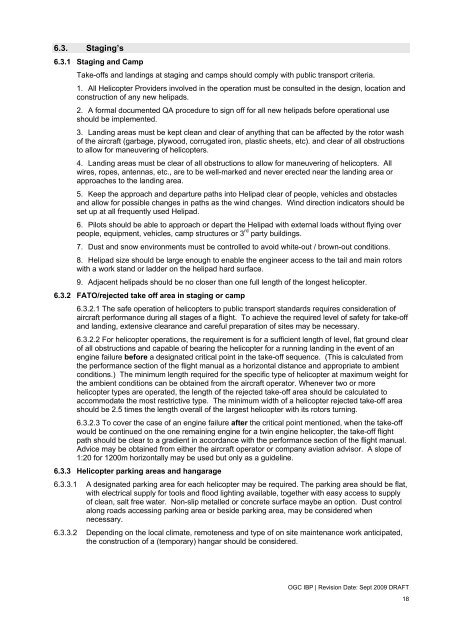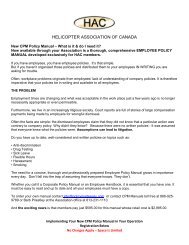HAC Oil & Gas IBP - Helicopter Association of Canada
HAC Oil & Gas IBP - Helicopter Association of Canada
HAC Oil & Gas IBP - Helicopter Association of Canada
You also want an ePaper? Increase the reach of your titles
YUMPU automatically turns print PDFs into web optimized ePapers that Google loves.
6.3. Staging’s6.3.1 Staging and CampTake-<strong>of</strong>fs and landings at staging and camps should comply with public transport criteria.1. All <strong>Helicopter</strong> Providers involved in the operation must be consulted in the design, location andconstruction <strong>of</strong> any new helipads.2. A formal documented QA procedure to sign <strong>of</strong>f for all new helipads before operational useshould be implemented.3. Landing areas must be kept clean and clear <strong>of</strong> anything that can be affected by the rotor wash<strong>of</strong> the aircraft (garbage, plywood, corrugated iron, plastic sheets, etc). and clear <strong>of</strong> all obstructionsto allow for maneuvering <strong>of</strong> helicopters.4. Landing areas must be clear <strong>of</strong> all obstructions to allow for maneuvering <strong>of</strong> helicopters. Allwires, ropes, antennas, etc., are to be well-marked and never erected near the landing area orapproaches to the landing area.5. Keep the approach and departure paths into Helipad clear <strong>of</strong> people, vehicles and obstaclesand allow for possible changes in paths as the wind changes. Wind direction indicators should beset up at all frequently used Helipad.6. Pilots should be able to approach or depart the Helipad with external loads without flying overpeople, equipment, vehicles, camp structures or 3 rd party buildings.7. Dust and snow environments must be controlled to avoid white-out / brown-out conditions.8. Helipad size should be large enough to enable the engineer access to the tail and main rotorswith a work stand or ladder on the helipad hard surface.9. Adjacent helipads should be no closer than one full length <strong>of</strong> the longest helicopter.6.3.2 FATO/rejected take <strong>of</strong>f area in staging or camp6.3.2.1 The safe operation <strong>of</strong> helicopters to public transport standards requires consideration <strong>of</strong>aircraft performance during all stages <strong>of</strong> a flight. To achieve the required level <strong>of</strong> safety for take-<strong>of</strong>fand landing, extensive clearance and careful preparation <strong>of</strong> sites may be necessary.6.3.2.2 For helicopter operations, the requirement is for a sufficient length <strong>of</strong> level, flat ground clear<strong>of</strong> all obstructions and capable <strong>of</strong> bearing the helicopter for a running landing in the event <strong>of</strong> anengine failure before a designated critical point in the take-<strong>of</strong>f sequence. (This is calculated fromthe performance section <strong>of</strong> the flight manual as a horizontal distance and appropriate to ambientconditions.) The minimum length required for the specific type <strong>of</strong> helicopter at maximum weight forthe ambient conditions can be obtained from the aircraft operator. Whenever two or morehelicopter types are operated, the length <strong>of</strong> the rejected take-<strong>of</strong>f area should be calculated toaccommodate the most restrictive type. The minimum width <strong>of</strong> a helicopter rejected take-<strong>of</strong>f areashould be 2.5 times the length overall <strong>of</strong> the largest helicopter with its rotors turning.6.3.2.3 To cover the case <strong>of</strong> an engine failure after the critical point mentioned, when the take-<strong>of</strong>fwould be continued on the one remaining engine for a twin engine helicopter, the take-<strong>of</strong>f flightpath should be clear to a gradient in accordance with the performance section <strong>of</strong> the flight manual.Advice may be obtained from either the aircraft operator or company aviation advisor. A slope <strong>of</strong>1:20 for 1200m horizontally may be used but only as a guideline.6.3.3 <strong>Helicopter</strong> parking areas and hangarage6.3.3.1 A designated parking area for each helicopter may be required. The parking area should be flat,with electrical supply for tools and flood lighting available, together with easy access to supply<strong>of</strong> clean, salt free water. Non-slip metalled or concrete surface maybe an option. Dust controlalong roads accessing parking area or beside parking area, may be considered whennecessary.6.3.3.2 Depending on the local climate, remoteness and type <strong>of</strong> on site maintenance work anticipated,the construction <strong>of</strong> a (temporary) hangar should be considered.OGC <strong>IBP</strong> | Revision Date: Sept 2009 DRAFT18









